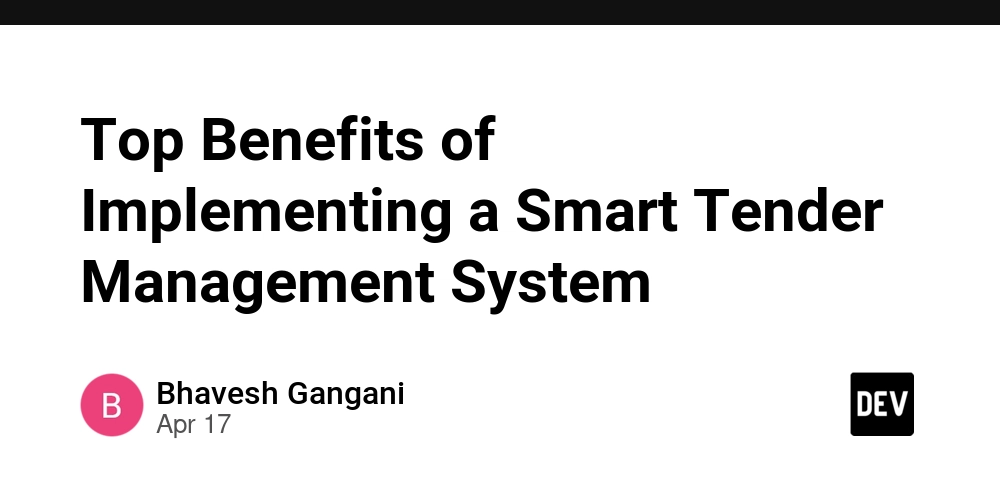Top Benefits of Implementing a Smart Tender Management System
In today’s fast-paced business landscape, traditional tendering processes are no longer sufficient. Paper-based workflows, manual bid evaluations, and fragmented communication often lead to inefficiencies, errors, and lost opportunities. As procurement becomes more strategic and time-sensitive, organizations are turning to Smart Tender Management Systems to revolutionize how they handle tenders. A Smart Tender Management System is a digital solution designed to streamline the tender lifecycle — from creation and publication to vendor evaluation and contract award. By automating repetitive tasks, enhancing transparency, and enabling data-driven decisions, this modern approach empowers businesses to stay ahead in competitive markets. In this blog, we’ll explore the top benefits of implementing a Smart Tender Management System and why forward-thinking businesses should make the shift now. What is a Tender Management System? A Tender Management System is a software platform that facilitates the end-to-end management of tendering processes — from creating and publishing tenders to evaluating bids and awarding contracts. It centralizes procurement operations, ensuring a structured, transparent, and efficient approach to vendor selection and project sourcing. Traditionally, organizations relied on emails, spreadsheets, and paperwork to manage tenders. This manual process was prone to delays, miscommunication, and compliance risks. A Smart Tender Management System eliminates these challenges by offering digital tools for automation, tracking, and analytics. Key Functions of a Tender Management System: Tender creation and publication Vendor registration and management Bid submission and clarification Evaluation scoring and decision-making Contract awarding and document archiving Whether you're in construction, manufacturing, government, or IT services, a Digital Tendering System brings consistency, control, and scalability to your procurement efforts. Why Go Smart? The procurement world is evolving — and so should your tendering process. A Smart Tender Management System isn't just a digital version of paper-based workflows; it's a transformative tool that leverages automation, real-time collaboration, and data intelligence to bring unprecedented efficiency and control. The Shift from Manual to Smart: Manual tendering often involves scattered documentation, time-consuming coordination, and increased chances of human error. Smart systems replace this outdated model with centralized platforms that allow teams and vendors to work together seamlessly in real time. Key Advantages of Going Smart: Automation: Automate repetitive tasks like document creation, vendor notifications, and deadline tracking. Transparency: Ensure every action is logged, traceable, and compliant with procurement regulations. Speed & Accuracy: Smart systems reduce turnaround times and increase the accuracy of bid evaluations. Analytics-Driven Decisions: Access real-time dashboards and reports to evaluate vendor performance and tender outcomes. By adopting an Automated Tendering Software, businesses can focus on strategy rather than chasing paperwork — making tendering faster, fairer, and more future-ready. Top Benefits of Implementing a Smart Tender Management System Implementing a Smart Tender Management System unlocks numerous advantages that can transform the way your organization handles procurement. From efficiency to transparency, let’s explore the top benefits of embracing this digital transformation. 1. Streamlined Tender Creation and Publishing With pre-built templates and centralized document storage, tender creation becomes quick and standardized. Publishing tenders across multiple platforms can be done with just a few clicks — eliminating delays and ensuring consistency. 2. Improved Vendor Management A Digital Tendering System allows you to manage vendor registrations, track performance history, and maintain a centralized supplier database. Prequalification criteria and automated scoring help in selecting the right vendors for every project. 3. Enhanced Transparency and Compliance Smart tendering tools provide full audit trails and version histories for every document and decision. This ensures internal accountability and helps meet industry regulations, especially in government and public-sector procurement. 4. Time and Cost Efficiency By reducing manual work and human errors, organizations save both time and resources. Smart workflows help teams focus on critical evaluations instead of chasing paperwork or managing follow-ups. 5. Better Bid Evaluation and Decision Making Advanced scoring algorithms, bid comparison tools, and automated evaluation criteria ensure faster and more objective decision-making. This results in better vendor choices and optimized project outcomes. Team members and vendors can collaborate via built-in messaging, shared workspaces, and notification systems.

In today’s fast-paced business landscape, traditional tendering processes are no longer sufficient. Paper-based workflows, manual bid evaluations, and fragmented communication often lead to inefficiencies, errors, and lost opportunities. As procurement becomes more strategic and time-sensitive, organizations are turning to Smart Tender Management Systems to revolutionize how they handle tenders.
A Smart Tender Management System is a digital solution designed to streamline the tender lifecycle — from creation and publication to vendor evaluation and contract award. By automating repetitive tasks, enhancing transparency, and enabling data-driven decisions, this modern approach empowers businesses to stay ahead in competitive markets.
In this blog, we’ll explore the top benefits of implementing a Smart Tender Management System and why forward-thinking businesses should make the shift now.
What is a Tender Management System?
A Tender Management System is a software platform that facilitates the end-to-end management of tendering processes — from creating and publishing tenders to evaluating bids and awarding contracts. It centralizes procurement operations, ensuring a structured, transparent, and efficient approach to vendor selection and project sourcing.
Traditionally, organizations relied on emails, spreadsheets, and paperwork to manage tenders. This manual process was prone to delays, miscommunication, and compliance risks. A Smart Tender Management System eliminates these challenges by offering digital tools for automation, tracking, and analytics.
Key Functions of a Tender Management System:
- Tender creation and publication
- Vendor registration and management
- Bid submission and clarification
- Evaluation scoring and decision-making
- Contract awarding and document archiving
Whether you're in construction, manufacturing, government, or IT services, a Digital Tendering System brings consistency, control, and scalability to your procurement efforts.
Why Go Smart?
The procurement world is evolving — and so should your tendering process. A Smart Tender Management System isn't just a digital version of paper-based workflows; it's a transformative tool that leverages automation, real-time collaboration, and data intelligence to bring unprecedented efficiency and control.
The Shift from Manual to Smart:
Manual tendering often involves scattered documentation, time-consuming coordination, and increased chances of human error. Smart systems replace this outdated model with centralized platforms that allow teams and vendors to work together seamlessly in real time.
Key Advantages of Going Smart:
Automation: Automate repetitive tasks like document creation, vendor notifications, and deadline tracking.
Transparency: Ensure every action is logged, traceable, and compliant with procurement regulations.
Speed & Accuracy: Smart systems reduce turnaround times and increase the accuracy of bid evaluations.
Analytics-Driven Decisions: Access real-time dashboards and reports to evaluate vendor performance and tender outcomes.
By adopting an Automated Tendering Software, businesses can focus on strategy rather than chasing paperwork — making tendering faster, fairer, and more future-ready.
Top Benefits of Implementing a Smart Tender Management System
Implementing a Smart Tender Management System unlocks numerous advantages that can transform the way your organization handles procurement. From efficiency to transparency, let’s explore the top benefits of embracing this digital transformation.
1. Streamlined Tender Creation and Publishing
With pre-built templates and centralized document storage, tender creation becomes quick and standardized. Publishing tenders across multiple platforms can be done with just a few clicks — eliminating delays and ensuring consistency.
2. Improved Vendor Management
A Digital Tendering System allows you to manage vendor registrations, track performance history, and maintain a centralized supplier database. Prequalification criteria and automated scoring help in selecting the right vendors for every project.
3. Enhanced Transparency and Compliance
Smart tendering tools provide full audit trails and version histories for every document and decision. This ensures internal accountability and helps meet industry regulations, especially in government and public-sector procurement.
4. Time and Cost Efficiency
By reducing manual work and human errors, organizations save both time and resources. Smart workflows help teams focus on critical evaluations instead of chasing paperwork or managing follow-ups.
5. Better Bid Evaluation and Decision Making
Advanced scoring algorithms, bid comparison tools, and automated evaluation criteria ensure faster and more objective decision-making. This results in better vendor choices and optimized project outcomes.
Team members and vendors can collaborate via built-in messaging, shared workspaces, and notification systems. Everyone stays informed and aligned, which leads to quicker resolutions and better outcomes.
7. Data-Driven Insights and Reporting
With smart analytics, your team can assess tender performance, vendor reliability, and bidding patterns. These insights support better procurement strategies and long-term planning.
8. Secure Document Handling and Digital Signatures
Security is critical. Smart systems offer encrypted storage, role-based access, and support for digital signatures — ensuring the confidentiality and authenticity of sensitive tender documents.
How Smart Tender Systems Empower Teams and Vendors
A Smart Tender Management System doesn’t just benefit the procurement department — it creates a collaborative environment where both internal teams and external vendors thrive.
Empowering Internal Teams
Procurement, finance, legal, and project teams can work together seamlessly within a centralized platform. No more chasing email threads or searching shared drives. Automated workflows and clear role assignments reduce bottlenecks and boost productivity.
Benefits for teams:
- Centralized task tracking and tender progress
- Reduced administrative burden
- Real-time access to critical documents
- Improved internal accountability
Empowering Vendors
Vendors also enjoy a smoother, more transparent experience. With online registration, automatic notifications, and easy-to-navigate submission portals, suppliers are more likely to participate and provide competitive, high-quality bids.
Benefits for vendors:
- Simplified bid submission process
- Instant updates and deadline alerts
- Fair, transparent evaluation criteria
- Secure communication with the tendering authority
By making the tendering process efficient and equitable for all parties, a Smart Tender Management System builds trust, encourages competition, and improves supplier relationships.
Industries That Benefit Most from Tender Management Systems
While any organization involved in procurement can gain value from a Smart Tender Management System, certain industries stand to benefit significantly due to the volume, complexity, or regulatory nature of their tendering processes.
1. Construction and Infrastructure
Managing bids from subcontractors, suppliers, and service providers can be overwhelming in large-scale construction projects. A Digital Tendering System helps streamline complex RFPs, evaluate technical qualifications, and ensure compliance with project timelines.
2. Manufacturing and Industrial Procurement
Manufacturers need to source raw materials, machinery, and maintenance services regularly. Automated tendering software ensures procurement teams can handle high-volume bidding and maintain transparency across their supply chains.
3. Government and Public Sector
Public procurement demands strict transparency, compliance, and auditability. A Tender Management System helps public entities ensure fair bidding practices and meet regulatory requirements like e-procurement mandates.
4. Healthcare and Pharmaceuticals
Hospitals and pharma companies often run tenders for equipment, drugs, and services. Smart tender platforms simplify vendor registration, track supplier compliance, and ensure timely acquisitions.
5. IT and Technology Services
From outsourcing projects to software development contracts, IT companies benefit from centralized bid tracking, technical evaluation scoring, and fast vendor onboarding through a Smart Tender Management System.
6. Energy and Utilities
Companies in oil & gas, renewable energy, and water utilities often deal with high-value tenders that require robust evaluation mechanisms, security, and documentation control — all of which are supported by automated tendering tools.
Conclusion
In a competitive, fast-moving market, manual tendering processes simply don’t cut it anymore. By adopting a Smart Tender Management System, organizations can move beyond outdated workflows and embrace a digital-first, automated, and collaborative approach to procurement.
Whether you’re aiming to improve vendor transparency, reduce bid processing time, or ensure better compliance — a Digital Tendering System is the key to smarter, faster, and more strategic tender decisions. From construction to government to manufacturing, businesses across industries are already reaping the benefits of this powerful tool.
If you're ready to transform your procurement process and gain a competitive edge, it’s time to invest in an Automated Tendering Software that aligns with your goals.










































































